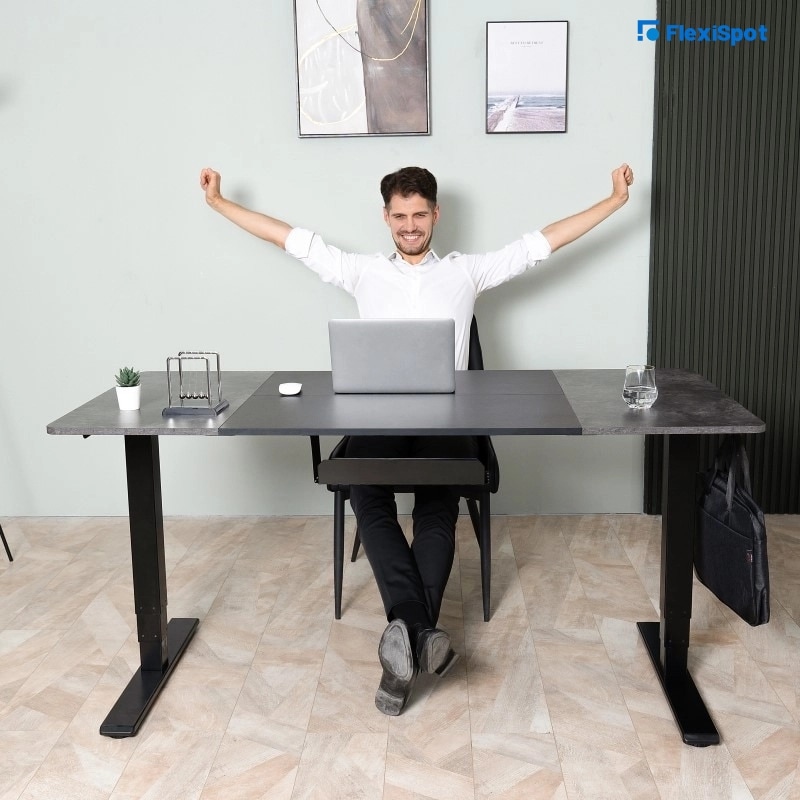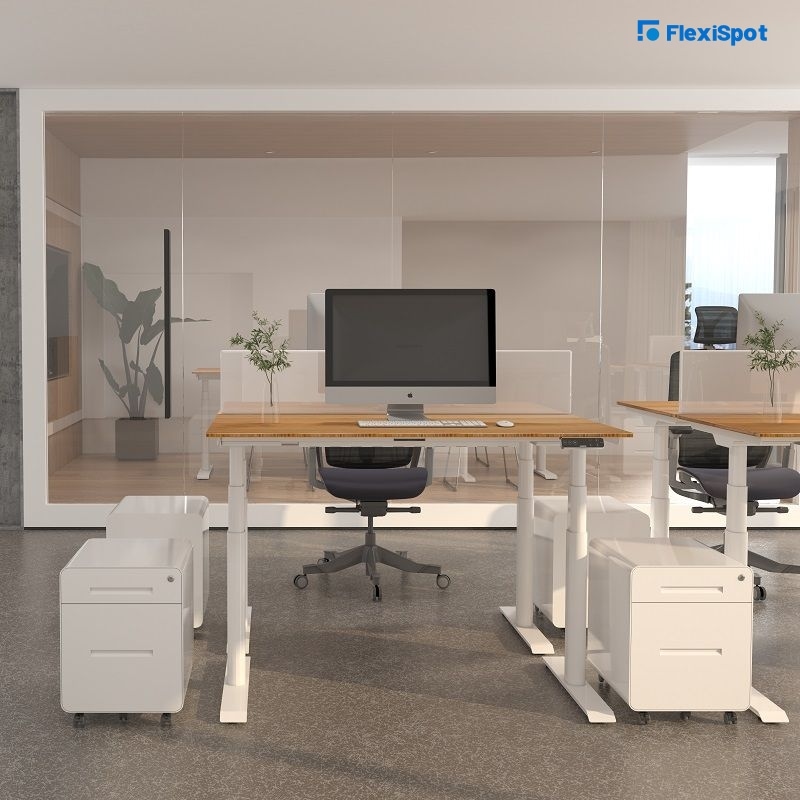Are you wondering how to incorporate ergonomics in a collaborative workplace? You might think that this is a complex design process, but we're happy to inform you that you might be mistaken. Every company, whether big or small, sets its ground for collaboration from the start. A healthy company ensures collaborative work because they know how important it is for growth.
Ergonomics, simply put, is an art, as well as a science. You can build a desk that is ergonomic, but building a desk that is ergonomic while ensuring that it supports collaborative work and increases the aesthetic of the office is challenging.
The evolution of collaborative work has discontinued the practice of sitting at a workspace for eight hours straight. Instead, employees engage in collaborative work in group or social settings. The advancement in technology has also allowed people to work in different locations, within as well as outside the office space.

How Incorporating Ergonomics Benefits an Office Space and Employees
Collaborative ergonomics helps make the workplace practical, health-conscious, and functional. Offices can either hinder the process or encourage employees to work together, boosting productivity. According to countless research, collaborative ergonomics is a way to help companies, regardless of how big or small they are, become productive and healthy.
Keep in mind that just because your workplace is ergonomic and collaborative does not mean that it cannot be aesthetically pleasing. Blending art and science can help create a new concept, especially for office furniture and how it looks. Over the years, companies who have adopted this style have claimed that it has helped improve their office space significantly.
The key to collaborative ergonomics is adaptation. The designs cannot be successful unless the employees adapt to the change. For this to happen, the desks in the workplace must be ergonomically efficient. Since the desk is the centerpiece, all other furniture, such as cabinets and storage, needs to be added around it without destroying the ergonomics of the workplace. You must aim to make it efficient so that everything is within arm's reach and just a chair spin away.
Every workplace needs an outlet that encourages collaboration, regardless of the kind of product or service they are selling. If collaboration is the main focus point, the company will grow significantly, and customers will also be happier.

How Ergonomic Workplaces Lower Physical Strain
If you want employees to be comfortable while working, you must ensure that they do not experience pain and discomfort. The following things should be included in a workplace that is trying to become ergonomic:
The desks and chairs should be height adjustable.
Desktops should be organized in work zones.
Everything should be within reach.
When employees have everything they might need within range, the risk of repetitive use injuries decreases as the employee will not have to put much strain on their body. If the desks are height adjustable, many employees can use the same desk, regardless of their difference in heights. By renovating your workplace, you can learn how to utilize the given space in a better way.
When it comes to desktop organization, all materials should be neatly put into different corners. These corners include primary/ repetitive, secondary/ occasional, tertiary/seldom. Once the desk is broken up into these corners, employees will be able to focus on their work better, increasing productivity.

How Collaborative Ergonomics Can Help Practical Applications in a Company
Here are ways in which collaborative ergonomics can help your company:
Densifying
One of the best times for collaborative ergonomics is when you are densifying. This usually happens when the company grows and hires more employees who need to fit into the same office space. If your office cannot be expanded, you must show some creativity with your office configuration.
You need to build an environment where employees have the tools and space they need to perform well without wasting any space. Collaborative ergonomics help build open or private offices without stacking up rows of cubicles that take up too much space.
Instead, each desk adopts an organic shape that creates an easy flow of desks so that guests and employees can comfortably socialize as well as work with one another. This is also an ideal solution for employees who need to collaborate on projects or take quick meetings. Every employee will be comfortable in their space without physically straining themselves.
Beautifying
When redesigning an office space, the décor, design, and wall color are paid the most attention to. However, what if we told you that the office furniture at your workplace could be used to beautify the space even further? Ergonomic furniture helps bring aesthetics to the office space so that your company looks and feels fulfilled.
You can opt for custom-made or semi-custom designed workstations so that they can fit the aesthetic of your workplace accordingly. This will help create a cohesive workplace that employees will like working in.
Expanding
If you choose to move to a bigger office, you can easily think about what all you want to include in the new space. However, it is important to make a clear plan on how you want to expand from the very start. How do you plan on expanding workstations as your company grows and more employees join the workplace?
One of the good things about expanding an office space is that you can create space for bigger workstations. If some employees need more monitors or a flat place to work, you can design ergonomic desks that fit both needs.
When it comes to incorporating ergonomics in a collaborative workspace, this also includes designing breakrooms, conference rooms, and reception areas. Usually, conference rooms need to have a number of outlets, including TV and USB ports. If you design conference tables to have these, it will make presenting during meetings much easier.
Contracting
If you choose to contract your space, you will be downsizing to a smaller office. This means that you might try to fit in more employees in a confined, congested space. This can interrupt the flow of problems, especially if there is not enough space to move around since desks will be everywhere.
In a situation like this, you must not think conventionally. When you have limited space, you need to adopt ergonomic solutions without causing discomfort to employees.

How to Incorporate Ergonomics in Collaborative Workspaces
To create an ergonomic, collaborative office, there needs to be a number of spaces that encourage social interactions around the workplace. Here are some tips to keep in mind:
Lounge Spaces are Not Meant for All Day Work
Even though the spaces in the office need to accommodate individual work, they should also allow group interaction and be designed in a way to encourage safe postures while one worker interacts with another.
Moreover, the spatial relationships between every furniture piece should not create unsafe postures for employees interacting with each other, for example, no employee should have to learn forward too much when talking or showing something on a device.
Furniture Items Should be Used to Provide Access to Data Modules
Power modules should be kept in a spot so that short cord lengths can be accommodated each time an employee has to use a device.
This way, you can limit stooping and bending by allowing employees to plug in their devices at their desks.
Height Adjustable Tables are a Must
In collaborative meeting spaces, it is important to have adjustable height tables. Usually, meetings do not last as long if everyone is standing. This also allows employees to take a break from sitting and fix their postures.
Lounge Furniture Must Support Ergonomic Postures
People who use tablets and laptops often find themselves doing so in uncomfortable postures. Hence, it is essential to select furniture that comes with a firm back and seat cushions and wide, soft armrests.
Attention should be paid to lounge furniture so that it can offer users support. You can also opt for furniture that can be adapted in terms of lumbar support and seat depth and in case arm support is needed in the center of the couch or when holding a device, tablet, or laptop.
Conclusion
The office spaces in recent times have significantly changed. Head-down work in a tiny cubicle is a thing of the past today. Today, you cannot separate employees from the use of technology, and workspaces require the use of social, group, and individual interactions.
To keep employees safe, happy, and comfortable, it is vital that all workplaces adapt collaborative ergonomics. Not only will this raise productivity, but it will also reduce the number of sick days and increase revenue.